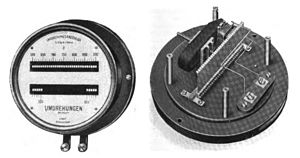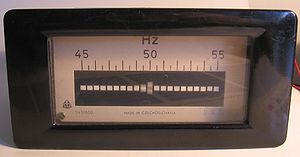Frequency
| Frequency | |
|---|---|
revolution per minute (rpm or r/min) | |
| In SI base units | s−1 |
Derivations from other quantities |
|
| Dimension | |
Frequency (symbol f), most often measured in
Frequency is an important parameter used in science and engineering to specify the rate of oscillatory and vibratory phenomena, such as mechanical vibrations, audio signals (sound), radio waves, and light.
For example, if a heart beats at a frequency of 120 times per minute (2 hertz), the period—the interval between beats—is half a second (60 seconds divided by 120
Definitions and units

For cyclical phenomena such as oscillations, waves, or for examples of simple harmonic motion, the term frequency is defined as the number of cycles or repetitions per unit of time. The conventional symbol for frequency is f or ν (the Greek letter nu) is also used.[3] The period T is the time taken to complete one cycle of an oscillation or rotation. The frequency and the period are related by the equation[4]
The term temporal frequency is used to emphasise that the frequency is characterised by the number of occurrences of a repeating event per unit time.
The
Period versus frequency
As a matter of convenience, longer and slower waves, such as
| Frequency | Period |
|---|---|
| 1 mHz (10−3 Hz) | 1 ks (103 s) |
| 1 Hz (100 Hz) | 1 s (100 s) |
| 1 kHz (103 Hz) | 1 ms (10−3 s) |
| 1 MHz (106 Hz) | 1 μs (10−6 s) |
| 1 GHz (109 Hz) | 1 ns (10−9 s) |
| 1 THz (1012 Hz) | 1 ps (10−12 s) |
Related quantities

- rotational motion.
- sine function:
- The unit of angular frequency is the sampling interval, which is a dimensionless quantity. Angular frequency is frequency multiplied by 2π.
- ξ (xi), is analogous to temporal frequency, but with a spatial measurement replacing time measurement,[note 1]e.g.:
- Spatial periodor wavelength is the spatial analog to temporal period.
In wave propagation
For periodic waves in nondispersive media (that is, media in which the wave speed is independent of frequency), frequency has an inverse relationship to the wavelength, λ (lambda). Even in dispersive media, the frequency f of a sinusoidal wave is equal to the phase velocity v of the wave divided by the wavelength λ of the wave:
In the special case of electromagnetic waves in vacuum, then v = c, where c is the speed of light in vacuum, and this expression becomes
When
Measurement
Measurement of frequency can be done in the following ways:
Counting
Calculating the frequency of a repeating event is accomplished by counting the number of times that event occurs within a specific time period, then dividing the count by the period. For example, if 71 events occur within 15 seconds the frequency is:
Stroboscope
An old method of measuring the frequency of rotating or vibrating objects is to use a stroboscope. This is an intense repetitively flashing light (strobe light) whose frequency can be adjusted with a calibrated timing circuit. The strobe light is pointed at the rotating object and the frequency adjusted up and down. When the frequency of the strobe equals the frequency of the rotating or vibrating object, the object completes one cycle of oscillation and returns to its original position between the flashes of light, so when illuminated by the strobe the object appears stationary. Then the frequency can be read from the calibrated readout on the stroboscope. A downside of this method is that an object rotating at an integer multiple of the strobing frequency will also appear stationary.
Frequency counter

Higher frequencies are usually measured with a
Heterodyne methods
Above the range of frequency counters, frequencies of electromagnetic signals are often measured indirectly utilizing
Examples
Light

Visible light is an
All of these waves, from the lowest-frequency radio waves to the highest-frequency gamma rays, are fundamentally the same, and they are all called electromagnetic radiation. They all travel through vacuum at the same speed (the speed of light), giving them wavelengths inversely proportional to their frequencies.
where c is the speed of light (c in vacuum or less in other media), f is the frequency and λ is the wavelength.In dispersive media, such as glass, the speed depends somewhat on frequency, so the wavelength is not quite inversely proportional to frequency.
Sound
Sound propagates as mechanical vibration waves of pressure and displacement, in air or other substances.[10] In general, frequency components of a sound determine its "color", its timbre. When speaking about the frequency (in singular) of a sound, it means the property that most determines its pitch.[11]
The frequencies an ear can hear are limited to a
In many media, such as air, the speed of sound is approximately independent of frequency, so the wavelength of the sound waves (distance between repetitions) is approximately inversely proportional to frequency.
Line current
In
Aperiodic frequency
Aperiodic frequency is the
It is defined as a
See also
- Audio frequency
- Bandwidth (signal processing)
- Chirp
- Cutoff frequency
- Downsampling
- Electronic filter
- Fourier analysis
- Frequency band
- Frequency converter
- Frequency domain
- Frequency distribution
- Frequency extender
- Frequency grid
- Frequency level
- Frequency modulation
- Frequency spectrum
- Interaction frequency
- Least-squares spectral analysis
- Natural frequency
- Negative frequency
- Periodicity (disambiguation)
- Pink noise
- Preselector
- Radar signal characteristics
- Radio frequency
- Signaling (telecommunications)
- Spread spectrum
- Spectral component
- Transverter
- Upsampling
- Orders of magnitude (frequency)
Notes
- ^ The term spatial period, sometimes used in place of wavelength, analogously corresponds to the (temporal) period.[9]
References
- ^ "Definition of FREQUENCY". Retrieved 3 October 2016.
- ^ "Definition of PERIOD". Retrieved 3 October 2016.
- ^ Serway & Faughn 1989, p. 346.
- ^ a b Serway & Faughn 1989, p. 354.
- ^ "Resolution 12 of the 11th CGPM (1960)". BIPM (International Bureau of Weights and Measures). Archived from the original on 8 April 2020. Retrieved 21 January 2021.
- ^ "Special Publication 811: NIST Guide to the SI, Chapter 8". NIST. 28 January 2016. Retrieved 2022-11-08.
- ^ Davies 1997, p. 275.
- ^ Young 1999, p. 7.
- ^ Boreman, Glenn D. "Spatial Frequency". SPIE. Retrieved 22 January 2021.
- ^ "Definition of SOUND". Retrieved 3 October 2016.
- ISBN 978-0-470-16794-6.
- ^ Condon, Tim (2003). Elert, Glenn (ed.). "Frequency range of dog hearing". The Physics Factbook. Retrieved 2008-10-22.
- ISBN 9781420009002.
- . sub§2.3.4, Table 4.
Sources
- Davies, A. (1997). Handbook of Condition Monitoring: Techniques and Methodology. New York: Springer. ISBN 978-0-412-61320-3.
- Serway, Raymond A.; Faughn, Jerry S. (1989). College Physics. London: Thomson/Brooks-Cole. ISBN 978-05344-0-814-5.
- Young, Ian R. (1999). Wind Generated Ocean Waves. Elsevere Ocean Engineering. Vol. 2. Oxford: Elsevier. ISBN 978-0-08-043317-2.
Further reading
- Giancoli, D.C. (1988). Physics for Scientists and Engineers (2nd ed.). Prentice Hall. ISBN 978-0-13-669201-0.

















